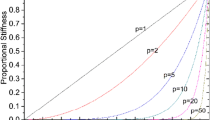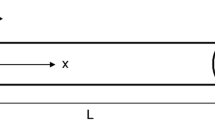Abstract
An automobile’s structure takes about 3000 to 6000 spot welds, and resistance spot welding is the most widely used because of its simplicity. Because it is a process that greatly influences the overall production cost, the automotive industry tends to decrease spot welds present in vehicle structure. With this, the majority of automobiles are unable to achieve satisfactory results in safety tests, such as crash tests. In addition to affecting safety in impact cases, the reduction in the number of spot welds implies a reduction in torsional and longitudinal vehicle stiffness, making it unstable and noisy. In view of the need for more studies on the effects of this reduction, this study uses numerical simulation and topology optimization to help assess the most appropriate spot weld distribution in a weldment, to maintain the torsional stiffness within acceptable limits. Results showed that structures obtained by topology optimization can have better stiffness and compliance compared to non-optimized structures.
Similar content being viewed by others
References
Ruiz D C, Batalha G F, Study of a failure mode criterion for resistance spot welding. II Brazilian Congress of Manufacturing Engineering COBEF, Joinville, SC, 2004
Cruz J, Torres E (2015) A methodology for modeling and control of weld bead width in the GMAW process. J Braz Soc Mech Sci Eng 37(5):1529–1541. https://doi.org/10.1007/s40430-014-0299-8
Dutra J, Silva R, Savi B, Marques C, Alarcon O (2016) New methodology for AC-pulsed GMAW parameterization. J Braz Soc Mech Sci Eng 38:99–107
Rocha L, Paiva AP, Paiva EJ, Balestrassi P (2015) Comparing DEA and principal component analysis in the multiobjective optimization of P-GMAW process. J Braz Soc Mech Sci Eng 38(8):2513–2526. https://doi.org/10.1007/s40430-015-0355-z
Siqueira R, Oliveira A, Riva R, Abdalla A, Baptista C, Lima M (2014) Mechanical and microstructural characterization of laser-welded. J Braz Soc Mech Sci Eng 37(1):133–140. https://doi.org/10.1007/s40430-014-0175-6
Husain N, Khodaparast H, Snaylam A, James S, Dearden G, Ouyang H, Finite-element modelling and updating of laser spot weld joints in a top-hat structure for dynamic analysis. Proc. IMechE Vol. 224 Part C: J. Mechanical Engineering Science (2010). https://doi.org/10.1243/09544062JMES178, 220, 8, 1099, 1108
Llanos C, Hurtado R, Alfaro S (2015) FPGA-based approach for change detection in GTAW welding process. J Braz Soc Mech Sci Eng 38(3):913–929. https://doi.org/10.1007/s40430-015-0371-z
Zhang Y, Taylor D (2001) Optimization of spot-welded structures. Finite Elem Anal Des 37(12):1013–1022. https://doi.org/10.1016/S0168-874X(01)00046-4
Xu S, Deng X (2004) An evaluation of simplified finite element models for spot-welded joints. Finite Elem Anal Des 40(9-10):1175–1194. https://doi.org/10.1016/j.finel.2003.08.006
Donders S, Brughmans M, Hermans L, Tzannetakis N (2005) The effect of spot weld failure on dynamic vehicle performance. Sound Vib 39(4):16–25
Bhatti Q, Ouisse M, Cogan S (2011) An adaptive optimization procedure for spot-welded structures. Comput Struct 89(17-18):1697–1711. https://doi.org/10.1016/j.compstruc.2011.04.009
Ertas A, Sonmez F (2010) Design optimization of spot-welded plates for maximum fatigue life. Finite Elem Anal Des 47(4):413–423. https://doi.org/10.1016/j.finel.2010.11.003
Karagoulis, M J. A nuts-and-bolts approach to the control of resistance spot welding. Welding Journals, 1994. 73, (7), 27–31
Mazur W, Kyriakopoulos A, Bott N, West D (2016) Use of modified electrode caps for surface quality welds in resistance spot welding. J Manufacturing Process 22:60–73. https://doi.org/10.1016/j.jmapro.2016.01.011
Vignesh K, Perumal AE, Velmurugan P (2017) Optimization of resistance spot welding process parameters and microstructural examination for dissimilar welding of AISI 316L austenitic stainless steel and 2205 duplex stainless steel. Int J Adv Manuf Technol 93(1-4):455–465. https://doi.org/10.1007/s00170-017-0089-4
Yürük A, Kahraman N (2017) Weld zone characterization of stainless steel joined through electric resistance spot welding. Int J Adv Manuf Technol 92(5-8):2975–2986. https://doi.org/10.1007/s00170-017-0335-9
Ouisse M, Cogan S (2010) Robust design of spot welds in automotive structures: a decision-making methodology. Mech Syst Signal Process 24(4):1172–1190. https://doi.org/10.1016/j.ymssp.2009.09.012
Chen S, Sun T, Jiang X, Qi J, Zeng R (2016) Online monitoring and evaluation of the weld quality of resistance spot welded titanium alloy. J Manufacturing Process 23:183–191. https://doi.org/10.1016/j.jmapro.2016.06.003
Vargas, J. H. Study of the formation, geometry and resistance of the point in resistance welding: a statistical approach. Mechanical engineering department, dissertation 2006. University of Brasilia, 143p
Wang R, Shang D (2005) Low-cycle fatigue life prediction of spot welds based on hardness distribution and finite element analysis. Int J Fatigue 31(3):508–514. https://doi.org/10.1016/j.ijfatigue.2008.04.009
Donders S, Brughmans M, Hermans L, Liefooghe C, Auweraer V, Desmet W (2006) The robustness of dynamic vehicle performance to spot weld failures. Finite Elem Anal Des 42(8-9):670–682. https://doi.org/10.1016/j.finel.2005.10.012
Takeda N, Kita Y, Papalambros Y, Optimization of welded structures with structural hot spot stress constraints. 9th World Congress on Structural and Multidisciplinary Optimization. June 13–17, 2011, Shizuoka, Japan
Pan N, Sheppard S (2002) Spot welds fatigue life prediction with cyclic strain range. Int J Fatigue 24(5):519–528. https://doi.org/10.1016/S0142-1123(01)00157-8
Lin S, Pan J, Wung P, Chiang J (2006) A fatigue crack growth model for spot welds under cyclic loading conditions. Int J Fatigue 28(7):792–803. https://doi.org/10.1016/j.ijfatigue.2005.08.003
Pan N, Sheppard S (2003) Stress intensity factors in spot welds. Eng Fract Mech 70(2):671–684. https://doi.org/10.1023/A:1007461430066
Moharrami R, Hemmati B (2017) Numerical stress analysis in resistance spot-welded nugget due to post-weld shear loading. J Manuf Process 27:284–290. https://doi.org/10.1016/j.jmapro.2017.05.007
Mirzaei F, Ghorbani H, Kolahan F (2017) Numerical modeling and optimization of joint strength in resistance spot welding of galvanized steel sheets. Int J Adv Manuf Technol 92(9-12):3489–3501. https://doi.org/10.1007/s00170-017-0407-x
Wan X, Wang Y, Zhao D (2016) Multi-response optimization in small scale resistance spot welding of titanium alloy by principal component analysis and genetic algorithm. Int J Adv Manuf Technol 83(1-4):545–559. https://doi.org/10.1007/s00170-015-7545-9
Zhang Y, Taylor D. Optimization of spot-welded structures. Finite Elem Anal Des 2001; 37(12): 1013–1022
Bhatti QI, Ouisse M, Cogan S (2011) An adaptive optimization procedure for spot-welded structures. Comput Struct 89(17-18):1697–1711. https://doi.org/10.1016/j.compstruc.2011.04.009
Ertas AH, Sonmez FO. Optimization of spot-weld joints. Proc Inst Mech Eng Part C: J Mech Eng Sci 2009; 223(3): 545–555, DOI: https://doi.org/10.1243/09544062JMES1171
Venter G, Beck A, Silva M (2014) A simple hierarchical procedure for parameter identification in robust topology optimization. J Braz Soc Mech Sci Eng 38(2):679–689. https://doi.org/10.1007/s40430-014-0271-7
Xiang Y, Wang Q, Fan Z, Fang H (2006) Optimal crashworthiness design of a spot welded thin-walled hat section. Finite Elem Anal Des 42(10):846–855. https://doi.org/10.1016/j.finel.2006.01.001
Silveira M, Fancello E (2015) The use of numerical optimization in the Blanks Soldiers project. Science & Engineering Journal 24(1):9–19
Riley W, George A. Design, analysis and testing of a formula SAE car chassis. SAE Technical Paper 2002–01-3300, 2002. doi: https://doi.org/10.4271/2002-01-3300
Norberg E, Lövgren S (2011) Topology optimization of vehicle body structure for improved ride & handling. Linköping University, Dissertation
Chae SW, Kwon KY, Lee TS (2002) An optimal design system for spot welding locations. Finite Elem Anal Des 38(3):277–294. https://doi.org/10.1016/S0168-874X(01)00064-6
Hasegawa H, Sasaki H, Uehara H, Kawamo K (2007) Optimization of spot-weld positions for vehicle design by using hybrid meta-heuristics. Int J Veh Des 43(1–4):151–172. https://doi.org/10.1504/IJVD.2007.012301
Pinheiro H, Study of the correlation between the current of shunt and the geometry of the spot weld as a function of performance in low carbon steel sheet and thickness of 0.8 mm. Technology College SENAI CIMATEC, Dissertation, Salvador, Brazil, 2010
Author information
Authors and Affiliations
Corresponding author
Rights and permissions
About this article
Cite this article
Junqueira, D.M., Silveira, M.E. & Ancelotti, A.C. Analysis of spot weld distribution in a weldment—numerical simulation and topology optimization. Int J Adv Manuf Technol 95, 4071–4079 (2018). https://doi.org/10.1007/s00170-017-1555-8
Received:
Accepted:
Published:
Issue Date:
DOI: https://doi.org/10.1007/s00170-017-1555-8




